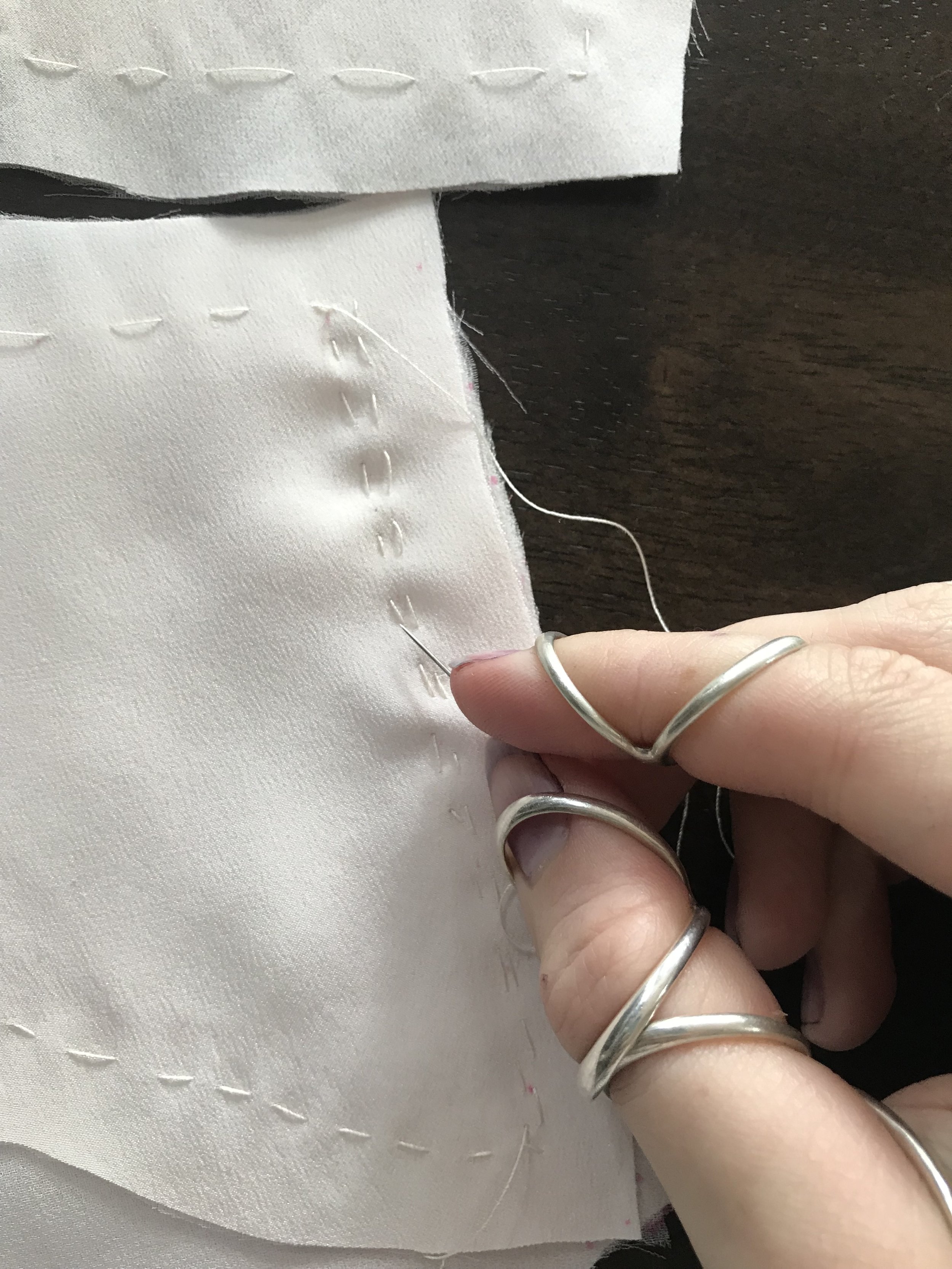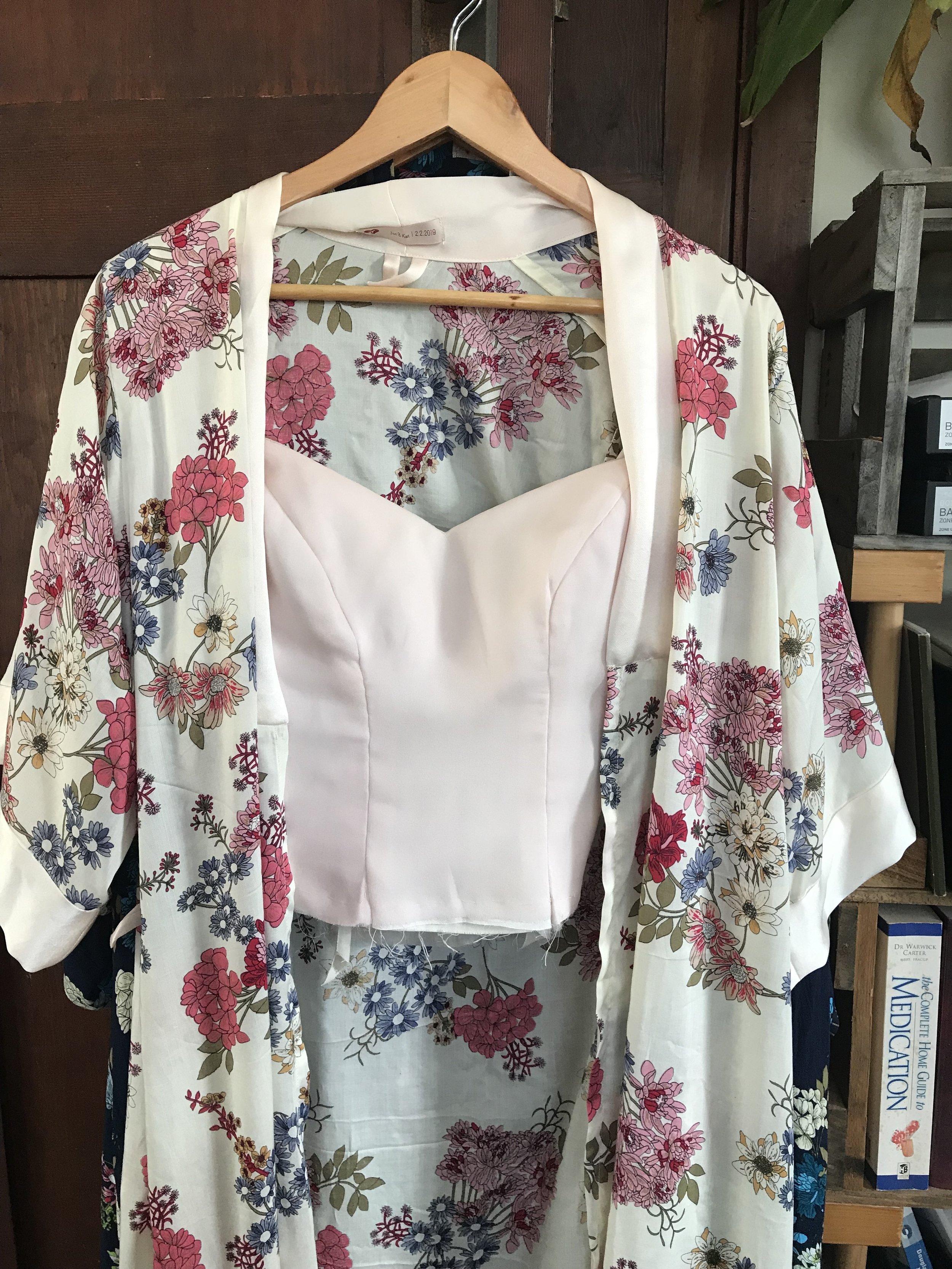The funny thing about this project is that for the majority of its in-progress time, it didn’t look like a dress at all. It looked like a pile of fabric and a funny looking embroidery frame. Today, I’m going to tell you about the weekend that started to change.
By this point, the corselet was ready and waiting and the embroidery was almost done - but I needed to construct the actual bodice of the dress. The fabric bodice is made of the same three layers as the skirt, which I did to ensure that the colors were cohesive throughout the dress. This meant cutting three of each pattern piece, of course. The fabric layers cover the corselet, but are visible through the embroidery. In my three wiggly silks (each of which behaved a bit differently), I had to be very careful when I constructed this piece, lest I end up with bubbling, which would turn to wrinkling when squished underneath the embroidery. Each piece had to be delicately cut, exactly on grain.
I did a lot of thinking about this, and a few tests, and decided on the following method (which I thankfully remembered to take approximately one million pictures of, you’re welcome :) You will, however, have to excuse my purple fingernails… some fabric dye from the Reception Dress that Never Was leaked into my gloves a few days prior… but that’s another story.)
My technique was a combination of old school and new school: couture techniques meet new technology. First, (above), I carefully laid each of the three fabrics on top of each other, matching the grainlines. I used my dress bodice piece with zero seam allowance (the same one I’d used to thread trace the embroidery on to the invisible tulle) to trace the shape onto the dress using dots with my pilot frixion pen. I chose dots because the action of dragging the pen across the surface of the fabric caused the layers to shift, and I tested to be sure that the frixion pen (which disappears with heat) wouldn’t stain my fabric.
After tracing the zero seam allowance line, I lined up a second version of the pattern piece with a 5/8” seam allowance, and traced that line in the same way. Once the cutting line was traced, I ever so carefully cut out all three layers of the fabric.
After cutting the piece out, but without moving the three stacked layers from the location where I’d cut them, I basted the layers together approximately 1/8” inside the sewing dotted lines. I used the smallest needle I could find, and silk basting thread for this step, and attempted to lift the fabric as little as possible until all edges were basted together. The purpose of this line of basting is to keep the three silks attached to each other - from this point forward I repeated the process with each of the 7 pattern pieces: Back, Side-Back, Side-front, and Front.
That’s all the first rows of basting finished! You can see that the strap connection points on the front piece had some shifting during basting - the top layer of gauze must not have been aligned on grain correctly, so it shifted - thankfully it stayed within the seam allowance, so this didn’t matter.
After the first round of basting, It was time to attach the pieces to each other, I tried various configurations of pinning so that I could hold them in the right place, and eventually decided that pinning along the seam (instead of across it) worked best and meant that I got stabbed the least. Always a good thing to keep blood off a white dress! I pinned the pieces right sides together, and then ran another line of basting 1/16” between the seam line and the first basting line, being careful to line them up on both sides. I could have basted on the actual seam line at this stage, but I chose not to because I didn’t want to risk not being able to pull my basting stitches out and having them visible on the right side of the bodice.
Once all the pieces were basted to each other, I carefully pressed the seams flat so that I could check the fit before sewing the seams permanently.
Each seam was still 1/16” away from the actual seam line, but that was fine for a quick check to make sure I had no wayward bubbling or skewed pieces. At this point, because I’d used the same pieces for the corselet, there wasn’t really a question over whether it would fit. It also really couldn’t not fit, because the embroidery at this stage couldn’t change shape. I pinned the silk bodice to the corselet along the top edges, plus a few additional pins to line up the seams at the waistline, and gave it a quick try-on. Thankfully, everything laid exactly how it was supposed to!
I pressed the seams back so that I’d be able to machine sew the final seams of the bodice, and then I - finally - after nearly four hours of basting - machine stitched my bodice together in under five minutes. I removed the second line of basting stitches, pressed and steamed my seams more aggressively flat, and with that, it was time to attach the bodice to the corselet!
The bodice is attached to the corselet along the top neck edge and the zipper, but only one of those things could happen before I constructed the skirt. I attached the lining and bodice to the corselet (and added the self fabric straps, which are tubes of satin with a piece of twill tape strung through), and then hung the bodice up until I was ready to attach it to the skirt. Doesn’t it look particularly cute under my bridal dressing gown? (It’s a Suki Kimono - I promise I’ll blog about it as well as the four others I made for us to get ready in!)
The next step was to make the skirt, and then unite the top half of my dress with the bottom half! Next week’s post, she’s REALLY going to start to look like a dress!











